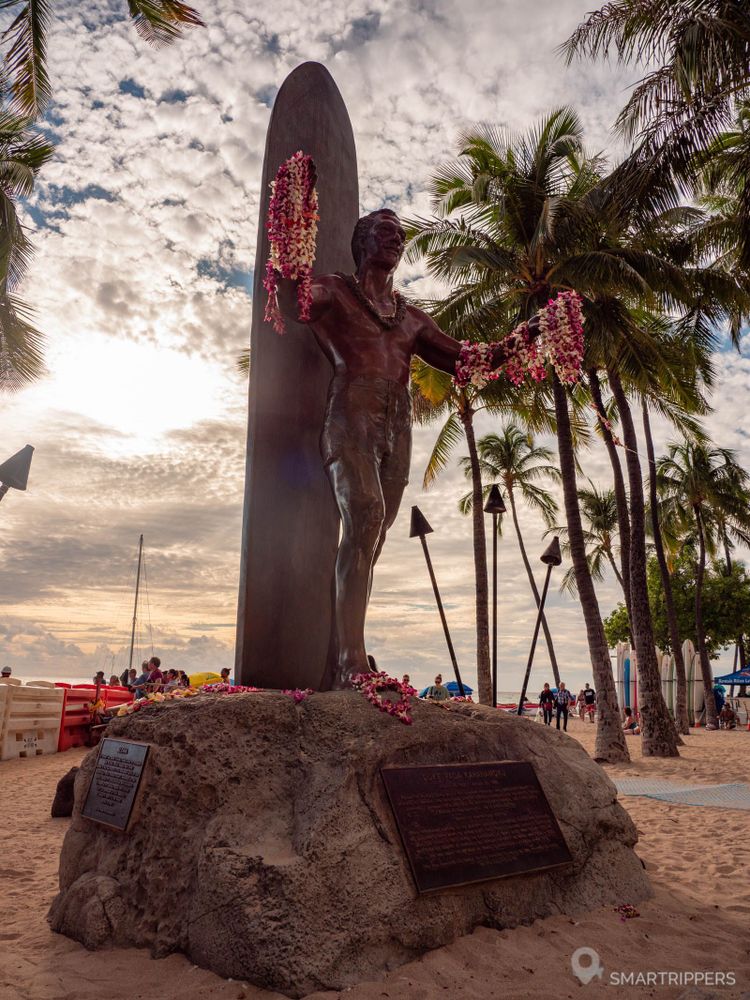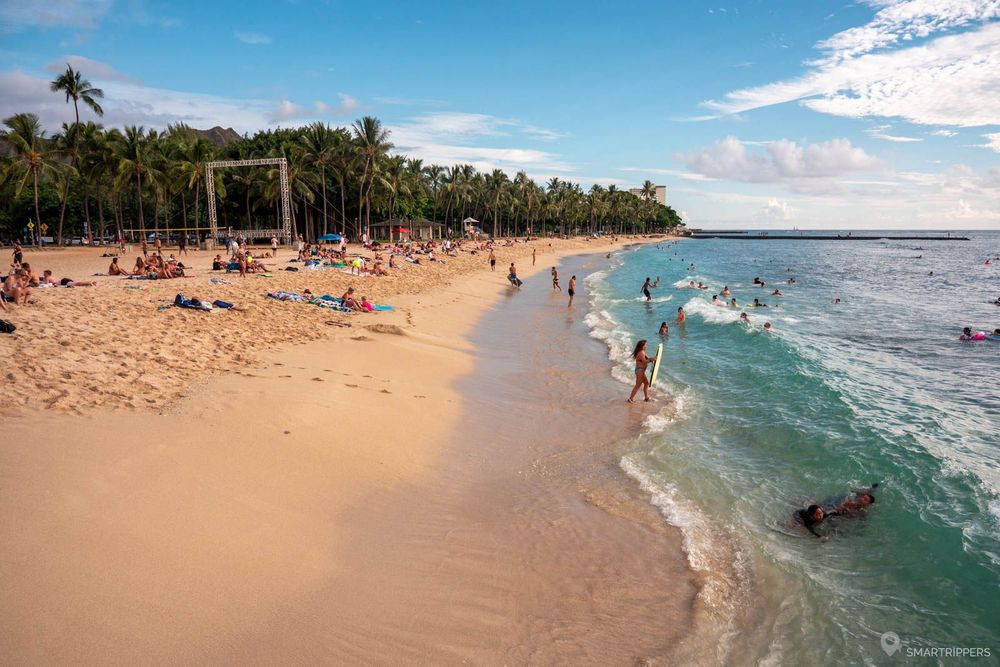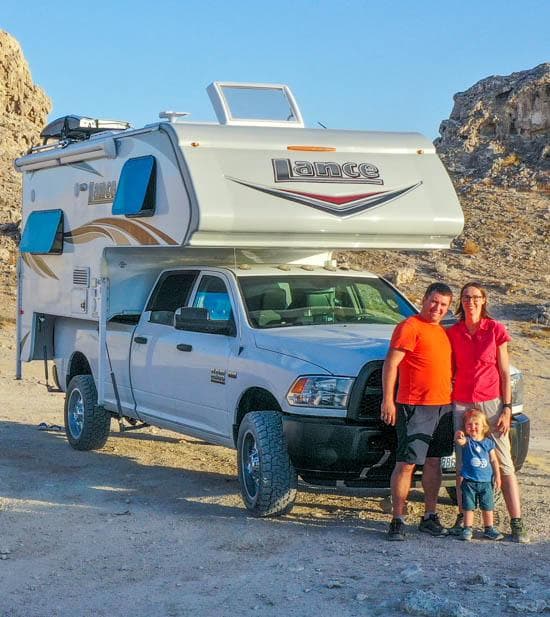
Welcome to Honolulu, the bustling city of Oahu. The Hawaiian capital city is distinguished by its large buildings. Hotels, offices and small apartments are nestled in the many skyscraper-like towers.
Honolulu's main attractions are to be found in the vicinity of the famous area of Waikīkī, which above all has a good number of beaches, stores and restaurants, without forgetting to linger a little on the city's historical heritage.
Summary
1Hawaii Capital Historic District
This is the historic district of Honolulu. The heart of the city was built not far from Honolulu's vast port. We find there the main historical institutions of the city with in particular the 'Iolani Palace or the Ali 'iōlani Hale which face each other.
'Iolani Palace
'Iolani Palace was the residence of the kings and queens of Hawaii for several decades, from 1882 until the overthrow of the monarchy in 1893. It was then used by the Hawaiian government until 1969.

Since then, the palace has been restored and turned into a museum. It can be visited on Wednesdays and Thursdays from 9:00 am to 2:30 pm and Fridays and Saturdays from 9:00 am to 3:00 pm. Several formulas of visits are offered and have a particular time slot. The self-guided tour with audio-guide is $20. It is recommended to book online before coming.
We didn't have the opportunity to go inside, but if you are interested in history, 'Iolani Palace is the only royal palace in the United States! The interiors are still decorated with period furniture.
Ali 'iōlani Hale
The Ali 'iōlani Hale faces the 'Iolani Palace. It was originally designed to be another royal palace, but that will never be the case. It was Kamehameha V who ordered its construction in 1872, after he finally decided to convert the palace into offices for the government. Today, the Supreme Court of Hawaii sits in the palace.
In front of the palace stands the statue of Kamehameha I, which was inaugurated in 1878 in commemoration of the centenary of Captain Cook's arrival. It is the substitute copy of the original statue that was initially lost at sea in its transport from Italy and was found several years later. The original statue can be seen on Big Island, in Kapaau.

Beaches in Ala Moana
Ala Moana is a neighborhood in Honolulu adjacent to Waikīkī. There is a large Mall full of stores if you want to do some shopping... as well as 2 beaches.
Ala Moana Beach
This Beach Park offers a large green area and a long sandy beach in the Ala Moana neighborhood, west of Waikīkī. The area is quite popular with locals who like to get together to do some sport.

The beach is simple, quite long, quite wide in places, but without any particular charm. Swimming is supervised and a large parking lot allows easy parking. Sanitary facilities and showers are located near the large parking lot.
Magic Island Lagoon
Right next to the Ala Moana Regional Park is this small lagoon protected by a dyke. The beach is not really welcoming, but the lagoon makes it a pleasant swimming spot for families. The beach is located at the end of a small cape, so it is set back from the hustle and bustle of the city.

Swimming is supervised. To get there you will have to cross the large green areas that start from the large parking lot of Ala Moana Beach.
2The beaches and attractions of Waikīkī
Bounded in part by the Ala Wai Canal, Waikīkī is the chic and upmarket district of Honolulu, at least for its sea side part (the canal side part is less luxurious). There are streets lined with coconut trees with impeccable green spaces, magnificent shopping malls and countless stores, hotels and restaurants.
Duke Kahanamoku Lagoon
The Duke Kahanamoku Lagoon is a small artificial lagoon at the foot of the Hilton. It doesn't have much to offer except if you want to paddle, canoe or pedal boat. The place remains however quite photogenic and the boardwalk along it is rather pleasant with its green spaces.

The lagoon is lined with sand but it is relatively shallow and the greenish water did not convince us much. If you wish to swim, it is best to head for the adjoining beaches overlooking the ocean.
To access it, it is possible to park in the public parking lot near the port next to the lagoon. If you are on foot, you will have to take Paoa Place and then take the Fort DeRussy boardwalk.
Friday's fireworks
If you're in the area on Friday night, be aware that the Hilton fires fireworks every Friday night at 7:45 pm. The tradition has been going on since 1988! You can admire the fireworks from the adjoining beaches or from your balcony if you are lucky enough to have a sea view.

Kahanamoku Beach
Kahanamoku beach faces the Duke Kahanamoku Lagoon. This arched beach is classic and quite crowded. Some coconut trees border the beach in places and the neighboring hotels put a few rows of deckchairs there, but they do not clutter the beach which is quite wide.

A dyke on the right protects the swimming area from large waves. The most pleasant place is in front of the big hotels, near the coconut trees.
Access is from Paoa Place and then take the Fort DeRussy boardwalk. Swimming is not supervised. A shower and restrooms are located at the end of Paoa Place.
Fort DeRussy Beach
In the continuity of Kahanamoku Beach is Fort DeRussy Beach. In the same style as the previous one, this long and wide sandy beach is bordered by pleasant wooded green areas. One will also find on the sand some deckchairs of the neighboring hotels.

Surfboards, paddle boards and pedal boats are available for rent on the beach. Access can be done on foot through Fort DeRussy Park or by taking the Sheraton boardwalk. Swimming is unsupervised.
The boardwalks of Waikīkī
The boardwalks are common in Hawaii. These coastal footpaths often allow you to stroll along the waterfront, or along the adjoining resorts. If you wish to stroll along the ocean, you can take the various boardwalks that follow one another.

They take the names of the hotels next to them and thus make it possible to join the Duke Kahanamoku Lagoon at Waikīkī Beach. Two passages are interesting at the Halekulani boardwalk and Sheraton boardwalk because they are close to the water and offer a beautiful view on Waikīkī and the Diamond Head.
Kalakaua Avenue
Kalakaua Avenue is one of the main avenues of Waikīkī. It runs along part of the waterfront. In the evening, the atmosphere is warm when the torches are burning!

It is not uncommon for the avenue to become pedestrian at the end of the day. Walkers come to set up their stalls and there is often a large crowd!
You can also choose to discover the area by Trolley, these small wooden buses often decorated. They are very popular with tourists and some are even dedicated to Japanese tourists.


Discover the Jurassic Valley and visit Hollywood Movie's & TV shows filming location! You can also enjoy Zipline, explore the jungle, take a horseback ride and many other activities!
Waikīkī Beach
The very famous Waikīkī Beach stretches along the bay of the same name. Located on the edge of the most lively area of Honolulu, the beach offers a long strip of sand bordering large hotel complexes. Among them, it is impossible to miss The Royal Hawaiian with its pink color. Built in 1927, it is one of the oldest hotels in the city and is still one of the icons of Waikīkī.
Waikīkī Beach also offers a beautiful view of Diamond Head, and its tall buildings facing the ocean complete the famous postcard of Honolulu known from TV series.
Nevertheless, the ransom of success is paid and you won't be alone in wanting to go to Waikīkī Beach. There is unfortunately a crowded beach (rare enough in Hawaii to be emphasized), both on the sand and in the water.

The bay of Waikīkī is also a very popular place for surfing because the waves are quite regular, although they are not very impressive.
If you would like to learn to surf, you can easily find surf schools here where you can register. Beginners are also very numerous.

We didn't find any washrooms or public showers on Waikiki Beach (there may be showers at the resorts), but you can find some at Kūhiō Beach Park.
It is best to walk to Waikiki Beach, as parking is limited in the area (or paid by the day). Swimming is supervised.
Duke Paoa Kahanamoku Statue

Duke Paoa Kahanamoku is a legend in Hawaii. This surfer and swimmer born in 1880 in Honolulu is one of the most famous personalities in the world of surfing. He is recognized for having made discover his favorite sport all over the world. He is even considered to be the inventor of modern surfing.
A statue has been erected in his memory at the end of Waikīkī Beach, along Kalakaua Avenue, and many Hawaiians still come to pay tribute to him. His statue is regularly adorned with flower necklaces.
Kūhiō Beach Park
As an extension of Waikīkī Beach, Kūhiō Beach Park offers access to two dyke-protected pools for safe swimming. The place is ideal for the youngest ones or if you want to practice swimming. The beach is narrower than the previous ones and lined with palm trees. It is a pity that there is still a lot of people there.



A footbridge has been built on the water south of the beach and allows you to walk a little in the bay. You will also discover a view of the beach with its buildings in the background.
Swimming is supervised and there are several showers along the beach as well as a large sanitary block in the middle of the Beach Park.
3Beaches south of Waikīkī
Once you leave Waikīkī, you will find a more relaxed atmosphere thanks to the large green spaces along the ocean. The buildings also give way to suburban areas. This is where the Honolulu Zoo is located, among others.
Queen's Surf Beach
Here is the last beach along Waikīkī. It follows almost directly Kūhiō Beach to extend over several hundred meters along the Kapiolani Beach Park. The north side of the beach is quite classic, offering a wide but short strip of sand.

The beach becomes more interesting as you go down south, as you approach the Kapiolani Beach Park. The proximity to the large green spaces isolates the beach from the city and gives it a much more pleasant setting. It is also less crowded than the other beaches at Waikīkī, which is due to its distance from the bustling center.
Swimming is supervised all along and a sanitary block is located at Kapiolani Beach Park. Numerous picnic tables are scattered throughout the park.
Kaimana Beach
We will come here more for the beautiful Banyan trees and the myriads of palm trees that grow here than for the beach which does not offer a real interest. The beach is not very wide, but it is mostly wedged between big buildings and a rather ugly wall.

Swimming is nevertheless supervised. Shower and sanitary facilities are on site and there are numerous picnic tables all along the roadside and seafront promenade.
Mākālei Beach Park
This small Beach Park gives access to a fine sandy beach below the esplanade on the right. The beach is not the prettiest but it allows to access the water and to isolate oneself. The green spaces of the park are dominated by a majestic tree, symbol of a successful fishing.


It will be difficult to park here due to the lack of parking spaces in the vicinity. On the infrastructure side, there is only a shower with a few picnic tables in the shade of the tree. Swimming is not supervised.
Lē'ahi Beach Park
The Lē 'ahi Beach Park offers only a beautiful lawn under the palm trees. Not much to do here, except to walk around. There is no parking nearby and no infrastructure on site.

Diamond Head Beach Park
The Diamond Head Beach Park is located just below the large crater of the same name. From the parking lot, a pedestrian and concrete path leads down to a beach very popular with surfers for its regular waves. The beach does not really have any charm, so we will come here more to see the surfers.


On the infrastructure side, there is only one shower on the beach. Swimming is not supervised. There is a parking lot where you can easily park your car.
4Climbing Diamond Head
We end this article by the Diamond Head, the must see crater of Oahu at the edge of which we discover a very beautiful view of Honolulu and its reef.
Diamond Head
Round trip of 2.5 km - 1h30 - Easy
A short distance from Honolulu, the Diamond Head crater dominates the city. This amazing formation is the result of the erosion of an old volcanic system of which only a ring of tuff remains today.
Diamond Head takes its strange name from the first British sailors who landed here and thought they saw diamonds in the brilliant calcite on its flanks.
Later, Diamond Head was used as a military base during the Second World War. Corridors and bunkers were built in the heights and are still accessible. Today, Diamond Head is one of the emblems of Oahu, and indeed one of the most popular hikes on the island. The 3 km round trip takes 1h30 to 2 hours and allows, from the bottom of the crater, to reach the ridge to have a nice view on the south of Honolulu, on the end of the south shore and the immensity of the Pacific Ocean.

The path is atypical because it passes through the former military underground corridors, before reaching two viewpoints from old bunkers.
When you arrive at the foot of a long and steep staircase, you will have the choice to go up to reach the first bunker, or to continue on the path that goes up on the left. The two paths meet a little further on to complete a small loop. So you will only have to choose your preferred route.

Because of the proximity to Honolulu, expect to find a lot of people there. You may also encounter difficulties in parking in the crater.
Access to Diamond Head is subject to a fee. If you park in the parking lot, it will cost you $10 per vehicle. The entrance fee will be 5$ if you walk in. Please note that Diamond Head is not open every day. It is currently open from Thursday to Sunday, but we recommend that you check the opening days and times at the park website.
That closes our article on the activities in the area of Waikīkī, in the heart of the Hawaiian capital.
We are Sandrine and Flo, French thirty-somethings. In 2019 we quit everything to live our dream, become nomads and travel around the world. We left with our baby, Lena, who was only 5 months old at the time. After a first trip around the Pacific Ocean by plane and a long 3 months stay in Hawaii, we left to discover Iceland for 3 months on board our 4WD pickup truck and truck camper. Then we continued our adventure in North America.

Today, if we can continue this adventure, it is above all thanks to our blog, Smartrippers! We created it one day in 2016, with the desire to share our good travel tips, without thinking that it would lead us there! We have developed it a lot over the years and have become experts on our 3 favorite destinations: Hawaii, Iceland and the American West. We now guide you to these destinations to help you plan the trip of your dreams!
Follow our adventures!